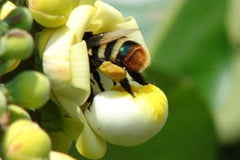
Enjoy the benefits of Brazil Nuts!
The Brazil nut tree is native to the Guianas, Venezuela, Brazil, eastern Colombia, eastern Peru, and eastern Bolivia. It occurs as scattered trees in large forests on the banks of the Amazon River, Rio Negro, Tapajos, and the Orinoco. It is a large tree, reaching to 50 m tall and with a trunk 1 to 2 m in diameter, making it among the largest trees in the Amazon rainforest. I may live for 500 years or more, some have been reported to be 1000 years. The stem is straight and commonly without branches for well over half the tree’s height, with a large emergent crown of long branches above the surrounding canopy of other trees.




Agouti
This is the only animal capable of opening the Brazil nut coco,they eat some of the seeds inside while burying others for later use; some of these can germinate into new Brazil nut trees.Most of the seeds are planted by the agoutis in shady places, and the young saplings may have to wait years, in a state of dormancy, for tree to fall and sunlight to reach it, when it starts growing again.
Euglossine Bee
The flowers can only be pollinated by large-bodied bees that are strong enough to pry open the flower hood and feast on the nectar within. These bees are known as Euglossine or orchid bees and are characterized by their large tongues and main habitat of undisturbed forest. These bees do not lend themselves to manipulation by humans, which may explain why fruit producing Brazil nut trees have not been successful grown in plantations or without the natural forest surrounding them.
Brazil Nut Fruit
The fruit takes 14 months to matures after pollination of the flowers. The fruit itself is a large capsule 10-15 cm in diameter, resembling a coconut endocarp in size and weighing up to 2 kg. IT has a hard, woody shell 8-12 mm thick, which contains 8 to 24 triangular seeds 4-5 cm long (the Brazil nuts) packed like segments of an orange.
Protecting the Rain-Forest
A profitable production of Brazil nuts requires pristine forest for its effective pollination. To preserve the forest there must be a greater incentive to keep it intact. When farmers make a good living keeping the forest as it is, then they will have less incentive to cut it down.
Brazil nuts provide an income for the locals in the Amazon rain-forest improving their quality of life by protecting the environment compared to other practices like hunting, logging and mining.

Empowered communities
Brazil nuts are harvested by castanheiros or Brazil nut collectors who walk along the forest floor with large baskets strapped to their backs. These collectors maintain customary rights to resources in these areas. The castanheiros travel by foot and boat to remote areas of the forest each year to forage for the nuts, only entering after the pods have dropped from the trees. Once harvested, they carry their loads to collection points often along the banks of the Amazon or one of its tributaries. The nuts are then transported on river barges down the Amazon to a local processing facility, where they are shelled, sorted, dried and cleaned by hand. During the harvest season, mostly female workers are employed in the processing facility, providing a much needed additional income to the communities in the area.




When the harvesting process is finished, and the nuts have been removed from the fruit, the nuts in their shells are transported in bags to sheds as protection from the rain. The harvest take place in the rain season, making climate conditions the first obstacle in a good recollection. They must be transported as soon as possible to regulated conditions since this is the process that most nuts are lost. At this point the nuts have a very high humidity level because they have been lying on the floor of the Amazon for several weeks. The materials are then calibrated (sized) into tiny/midget/medium/large, the international sizing format for Brazil nuts. Raw in-shell nuts are received at the factories in large sacks. Once calibrated, the nuts pass down the line to the Autoclave, which is a large heated cylinder. This begins the drying process and helps to separate the protective nut shell from the nut kernel.
Traditionally most processing factories have used the hand cracking method but more recently several plants have converted to a mechanical cracking system to remove the individual nut shells from the kernels. Hand cracking is a huge source of employment for the town – normally a whole family unit is employed, sitting at one cracking table where they rotate on shifts, each taking their turn to crack the nuts and earn an income for their families. Hand cracked nuts are also seen by many to be of better quality because it results in less damage to the kernel when compared to mechanical cracked nuts. Plants switching to mechanical cracking feel they are getting increased throughput in the factory and saving on labor costs in the long term.


Once cracked the kernel passes through several quality control lines where teams of woman work to hand select out rotten or damaged nuts. Most factory employees are woman as the men tend to be out collecting the nuts in the forest. The kernel materials also pass under aflatoxin lights. Aflatoxin is a bacteria mold that can grow on nuts when there is prolonged exposure to wet conditions. These conditions are characteristic of the forest floor of the Amazon, so it is important that the collectors recover the nut pods from the forest at the right time. This is a critical part of the production process because to allow export and import of Brazil nut materials, aflatoxin levels need to be within a specified range.
Next the kernels are dried in metal trays for anywhere between 15 to 20 hours at high temperatures to take the humidity level down to a moisture level of about 4.5%. After another check for kernels with defects and one more aflatoxin check the goods come off the production belt and enter the packing room. Kernels are packed into cartons, ready for export.




Health Benefits
Brazil nuts are rich in antioxidants, vitamins, proteins and essential fatty acids. Their nutrient content have been prove to improve health in different organ systems.


